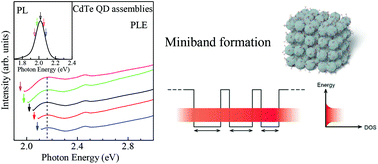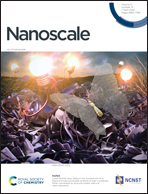Coupled electronic states in CdTe quantum dot assemblies fabricated by utilizing chemical bonding between ligands†
Abstract
Semiconductor quantum dot superlattices (QDSLs) have attracted much attention as key materials for realizing new optoelectronic devices such as solar cells with high conversion efficiency and thermoelectric elements with high electrical conductivity. To improve the charge transport properties of QDSL-based optoelectronic devices, it is important that the QD structures form minibands, which are the coupled electronic states between QDs. A shorter inter-QD distance and a periodic arrangement of QDs are the essential conditions for the formation of minibands. In this study, we use CdTe QDs capped with short ligands of N-acetyl-L cysteine (NAC) to fabricate three-dimensional QD assemblies by utilizing chemical bonding between NACs. Absorption spectra clearly display the quantum resonance phenomenon originating from the coupling of the wave functions between the adjacent QDs in CdTe QD assemblies. Furthermore, we demonstrate the formation of minibands in CdTe QD assemblies by examining both, the excitation energy dependence of photoluminescence (PL) spectra and the detection energy dependence of PL excitation spectra. The fabrication method of QD assemblies utilizing chemical bonding between NACs can be applied to all QDs capped with NAC as a ligand.



 Please wait while we load your content...
Please wait while we load your content...
